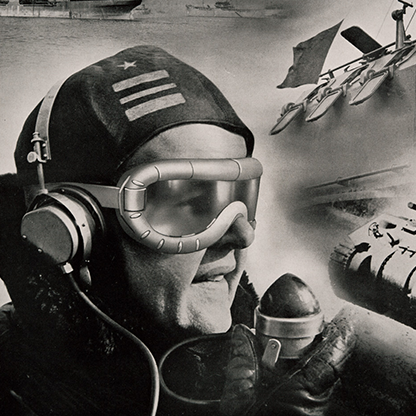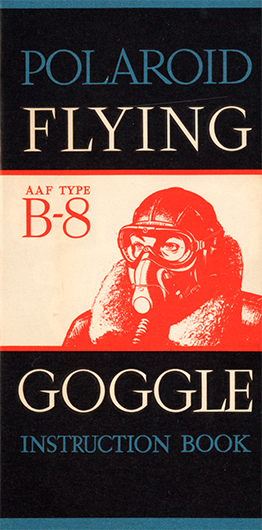
Vannevar Bush, formerly dean of engineering and vice-president at MIT, recognized the challenges of pushing new technologies through the red tape of the military. With Harvard President James Bryant Conant and MIT President Karl Taylor Compton, Bush encouraged the pursuit of wartime research at existing laboratories in universities and companies.26 As head of the Office of Scientific Research and Development during World War II, Bush enlisted Polaroid in the cause, and the company entered into a contract with the National Defense Research Committee to create a range of products for the military.
In December 1940, Land assembled his employees to tell them that all efforts of the company would now be directed toward the war effort. Polaroid's new facility in Cambridge was located in the industrial area of Kendall Square with affordable rents and neighbors that included the New England Confectionery Company (Necco), the Cambridge Rubber Company, and Lever Brothers. Here Polaroid began producing polarizing filters for gunsights, binoculars, periscopes, rangefinders, and infra-red night viewing devices. With variable density goggles, anti-aircraft and machine gunners could darken the field of vision to the desired degree by turning the knob of the goggle lenses. Polaroid also produced goggles for military dogs and mules to protect their eyes from debris. In 1944, Life magazine noted that "every U.S. fire-control instrument is equipped with filters and every second man in combat wears filter goggles. Most of these are produced by the Polaroid Corp."27 In 1943, Newsweek magazine featured on its cover a photograph of U. S. Army General George Patton wearing Polaroid goggles.28
The Polaroid facility included a machine gun training room with 20-foot high ceilings equipped with a replica of a 20-millimeter automatic cannon on a pedestal mount. Machine gun trainers aimed the canon at a 3-D screen that projected enemy planes, while loudspeakers resounded with engine noise, incoming machine gun fire, and detonations made by the trainers. Optical tracers recorded the number of hits made.
Another Polaroid contribution toward the war effort included the production of quinine. Natural quinine was derived from the bark of tropical tree in Java, but this source was cut off by the Japanese occupation. Polaroid sponsored the work of MIT graduate Dr. Robert Burns Woodward and Dr. William von Eggers Doering, a Harvard postdoctoral fellow under Woodward. Working in a Harvard laboratory, the two succeeded in developing a synthetic form of the compound, which the military relied on to treat malaria.
During the war, Polaroid made a foray into still photography with the production of a stereo image known as a Vectograph. A professor of art at Smith College who earned his doctorate at Harvard and became an early consultant to Polaroid, Clarence Kennedy had investigated the use of 3-D photography for projecting photographs of works of art, particularly sculpture. Joseph Mahler, a Czech inventor who immigrated to the United States in 1938 and came to work at Polaroid, had received a patent for an "Apparatus Employing Polarizing Light for the Production of Stereoscopic Images." The Vectograph consisted of an image for the left eye and another image for the right eye laminated one on top of the other on a single strip of film. As opposed to traditional stereo prints, Vectographs represented shadows in high polarization and highlights in low polarization, thus combining polarizing technology with photography. When viewed through polarizing viewing lenses, images appeared in high relief, which proved especially effective for wartime reconnaissance.
Mahler made the first Vectograph for Land in January 1938. Thousands of Vectographs with accompanying records from the corporate archives reveal that the development and refinement of the process proceeded quickly.29 During the war, Polaroid contributed $2 million toward Vectograph production and established the Polaroid War School where more than fifteen hundred military personnel learned how to make Vectographs. Early applications of the process at Guadalcanal rendered details of buildings, airplanes, and guns on the ground. The military began to use Vectographs in subsequent campaigns including the Allied invasion of Normandy.
During the war years, Polaroid annual sales rose from $1,032,425 to $16,752,465, and the company employed 1,250 employees.30 Land's effective marshaling of resources, adaptation to new assignments, and gathering of scientific talent during the conflict positioned Polaroid well to enter into its next creative phase.
- 25. Edwin H. Land, "Annual Christmas Message to Employees of Polaroid Corporation," University Theatre, Cambridge, MA, December 23, 1942, 8, Edwin H. Land speech files, Polaroid Corporation Records, Baker Library, Harvard Business School.
- 26. After the war Compton helped establish American Research and Development, the first publicly funded U.S. venture capital company.
- 27. "Light Control: Polaroid Filters Make Enemy Targets Easier to See," Life 16, no. 6 (February 7, 1944): 72.
- 28. "General Patton: From Tunisia to Sicily," Newsweek 22 (July 26, 1943).
- 29. Brenda Bernier, "Polaroid Vectographs," Topics in Photographic Preservation 13 (2009): 89.
- 30. Sales figures based on "Net Sales and Income from Royalties, Research and Other Sources," Polaroid Corporation Annual Report 1941, and "Net Sales & Income from Royalties, Research and Other Sources," Polaroid Corporation Annual Report 1945, 5. Employee figure from Polaroid Corporation: A Chronology, 1930–1980, 1, Polaroid Public Relations and Communications, 1983, Polaroid Corporation Administrative Records, Box I.243, Folder 2, Baker Library, Harvard Business School.




